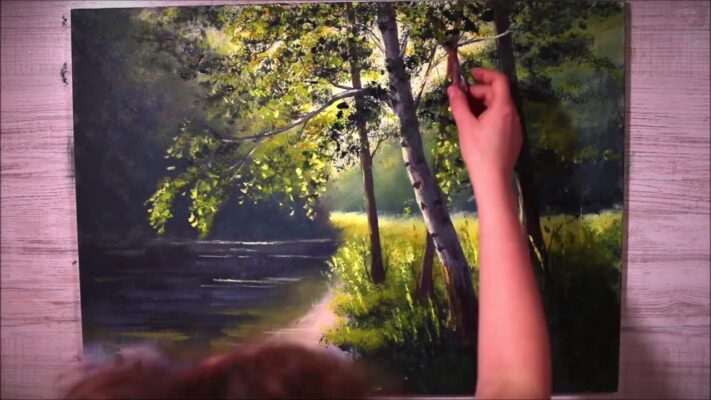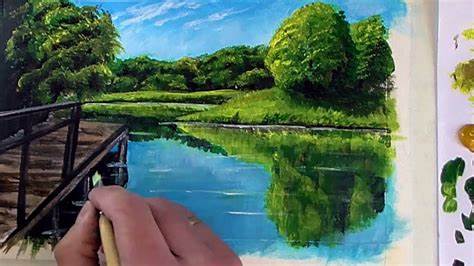Painting landscapes can be one of the most rewarding experiences for an artist. Whether you’re a beginner or a seasoned pro, mastering the art of landscape painting requires both technical knowledge and a personal touch. In this article, we will delve into essential painting landscapes tips that can help you elevate your work and make your landscapes come alive.
Landscape painting is not just about capturing a scene; it’s about translating the emotions and feelings evoked by nature onto the canvas. Through careful observation, practice, and application of various techniques, you can learn how to breathe life into your landscapes.

Understanding Composition in Landscape Painting
Composition is the backbone of any artwork, and landscape painting is no exception. A well-composed piece can lead viewers through the scene, guiding their eyes toward focal points while creating balance and harmony. As we explore composition in landscape painting, we’ll look at the rule of thirds, the importance of line, and how to create depth in your artwork.
The Rule of Thirds
The rule of thirds is a fundamental principle in visual arts that divides the canvas into nine equal sections using two vertical and two horizontal lines.
This technique allows artists to position key elements along the lines or at their intersections. By doing so, you can create more dynamic and interesting compositions that draw the viewer’s eye into the artwork.
When applying this rule to landscape painting, consider placing the horizon line either on the top or bottom third of the canvas. This decision will guide the viewer’s focus, highlighting either the sky or the foreground. Experimentation can yield stunning results, as breaking the rule occasionally leads to captivating compositions that defy conventional expectations.
Leading Lines
Lines are powerful tools in composition; they can direct the viewer’s gaze and establish a sense of movement within your piece.
In landscape painting, natural elements such as rivers, paths, or mountains can serve as leading lines. By carefully positioning these features in your composition, you can create a journey for the viewer to follow, enhancing their engagement with the artwork.
To effectively utilize leading lines, think about how they interact with other components in your landscape. For example, a winding river can lead the viewer to a distant mountain range, establishing a clear narrative throughout the painting.
Creating Depth and Perspective
Creating a sense of depth and perspective can transform a flat canvas into a three-dimensional landscape. When painting, you can achieve depth through overlapping elements, color saturation, and atmospheric perspective.
Overlapping objects naturally conveys spatial relationships. For instance, when painting a forest, trees in the foreground should partially obscure those in the background. This layering technique adds realism and dimension to your landscape.
Additionally, color saturation plays a critical role in establishing depth. Colors fade and become less saturated as they recede into the distance, mimicking the effects of atmosphere. For example, warmer colors tend to appear closer, while cooler hues suggest distance. Paying attention to these subtle changes will enhance the overall perception of space within your artwork.
Choosing the Right Color Palette
Colors evoke emotions and can profoundly influence the mood of a landscape painting. Selecting the right color palette can enhance the beauty of your work, making it stand out while conveying the message you wish to tell through your art.
In this section, we will discuss understanding color theory, the importance of value and contrast, and how to capture the essence of different seasons through color choices.
Understanding Color Theory
Color theory forms the foundation of how colors interact and work together. Knowing the primary, secondary, and tertiary colors allows you to mix and create a wide range of hues, giving you the freedom to express your artistic vision.
Using a color wheel can help you identify complementary, analogous, and triadic color schemes, which contribute to composition harmony. Complementary colors, for example, are directly opposite each other on the color wheel, creating striking contrasts when placed side by side. By incorporating these combinations into your landscape paintings, you can evoke powerful emotional responses from viewers.
The Importance of Value and Contrast
Value refers to the lightness or darkness of a color, while contrast highlights the differences between colors and values. Both aspects are crucial for achieving depth and interest in your paintings.
High contrast areas can draw attention to focal points within your landscape, while low contrast regions can create a sense of tranquility. For example, you may want to paint a sunset where the bright oranges and yellows of the sun contrast sharply against the deep blues of the twilight sky, capturing the viewer’s attention.
Experimenting with value scales can also improve your skills in creating contrasts that speak volumes about the mood and atmosphere of your painting. The interplay of light and shadow can add complexity and intrigue to your landscapes, inviting viewers to linger over the details.
Capturing Seasonal Colors
Every season offers a distinct palette that can inspire unique landscape paintings. Spring bursts with vibrant blooms, summer glows with lush greens, autumn dazzles with warm ochres and reds, and winter presents a stark yet beautiful palette of whites and grays.
Understanding how to portray the characteristics of each season can enrich your artwork. During spring, for example, focusing on fresh greens and soft pastel colors can evoke feelings of renewal and growth. In contrast, capturing the crisp air and muted tones of winter can convey a sense of solitude and peace.
When painting landscapes inspired by seasonal changes, don’t hesitate to experiment with colors that may not be strictly accurate. Artistic interpretation can give your landscapes a unique identity, allowing you to inject your personality and experiences into the artwork.

Mastering Perspective and Atmosphere
Perspective and atmosphere significantly impact the overall feel of a landscape painting. By understanding how to manipulate these elements, you can create captivating scenes filled with depth and emotion.
This section will explore linear perspective, aerial perspective, and the role of light and shadow in establishing atmosphere within your landscapes.
Linear Perspective
Linear perspective is a technique used in art to create the illusion of depth and space on a flat surface. It involves drawing lines that converge toward a single vanishing point on the horizon, simulating how our eyes perceive objects receding in space.
In landscape painting, you can apply linear perspective to roads, rivers, or rows of trees. By accurately depicting how these elements diminish in size as they move away from the viewer, you’ll create a more realistic sense of depth.
As you practice linear perspective, take note of how different viewpoints can dramatically change the composition. A bird’s-eye view may provide a sweeping panorama, while a worm’s-eye view can emphasize the grandeur of trees towering above.
Aerial Perspective
Aerial perspective, often referred to as atmospheric perspective, is another essential technique in landscape painting. This method allows you to depict the effect of the atmosphere on distant objects, creating an illusion of depth.
In reality, objects further away from us appear lighter and less detailed due to particles in the atmosphere. To replicate this in your artwork, gradually lighten the colors of distant mountains or hills, adding a slight bluish tint to mimic the natural haze.
By mastering aerial perspective, you’ll not only enhance the depth of your landscapes but also evoke a sense of vastness and beauty that draws viewers into the heart of your painted world.
The Role of Light and Shadow
Light and shadow play a crucial role in setting the mood and tone of your landscape painting. Observing how natural light interacts with various forms can reveal exquisite details and create dramatic contrasts.
To capture the essence of light, consider the time of day and weather conditions when painting. Morning light, for example, has a soft golden hue that brings warmth and intimacy, while late afternoon light casts long shadows, adding drama and mystery.
Consider how to use shadows to define shapes and create textures. Shadows can lend dimension to trees, rocks, or hills, giving your landscape a sense of reality. Remember that the direction of the light source will influence where shadows fall, so take time to observe these nuances in your surroundings.
Techniques for Enhancing Texture
Texture can bring landscapes to life, adding depth and realism that translates into an immersive viewing experience. Various techniques can enhance texture in your paintings, making them richer and more engaging to the viewer.
In this section, we will examine the importance of brushwork, layering techniques, and the use of mixed media to create texture in landscape painting.
Brushwork Techniques
Brushwork is one of the most effective ways to express texture in your landscape paintings. Different brush techniques can convey various textures, from the rough bark of trees to the smooth ripples of water.
Experimenting with different brush types and strokes can yield exciting results. For instance, using a fan brush to create foliage can produce a lively and dynamic effect, whereas a flat brush can be perfect for making broad strokes in the sky.
Incorporating dry brushing techniques can also add textured layers to your landscapes. Dry brushing involves using minimal paint to lightly drag the brush across the surface, creating a scratchy, textured effect ideal for highlighting grass or rocky surfaces.
Layering Techniques
Layering is an essential aspect of building texture in landscape painting. This technique involves applying multiple layers of paint to create depth and richness in your artwork.
Start with a base layer of colors and then gradually build up additional layers, allowing each one to dry before applying the next. This approach can enhance the vibrancy of your colors and create intricate textures, especially when painting details like clouds or waves.
Don’t hesitate to experiment with glazing—applying thin, transparent layers of paint over dried layers. This method will allow underlying colors to shine through, adding luminosity and depth to your landscape.
Mixed Media Approaches
Mixed media art involves combining different materials and techniques, allowing for creative exploration and experimentation. Using mixed media can introduce unique textures and effects that traditional paint alone cannot achieve.
For instance, you might incorporate sand or small pebbles into your paint to create a tactile quality reminiscent of a sandy beach or rocky terrain. Alternatively, collage elements like torn paper or fabric can add layers of meaning and depth to your landscapes.
Experimenting with mixed media encourages spontaneity and creativity, providing opportunities to push the boundaries of traditional landscape painting. Don’t shy away from trying unconventional materials or methods—you might discover new avenues for expression in your art.

Conclusion
Elevating your landscape painting requires a combination of knowledge, experimentation, and the willingness to embrace your artistic voice. Through understanding composition, color theory, perspective, atmosphere, and texture, you can create landscapes that resonate with viewers and evoke strong emotions.
Remember that each painting is an opportunity to express your unique vision and connect with the natural world around you. Keep exploring and honing your skills, and let the painting landscapes tips shared in this article guide you on your artistic journey.

